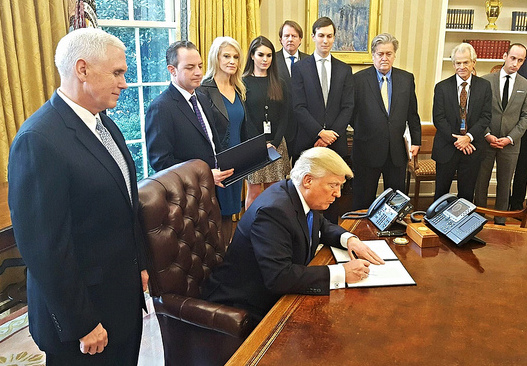
Under President Trump’s executive order, the benefits of new regulations will play no role in regulatory decision-making.
The reactions to President Donald Trump’s new executive order (EO), “Reducing Regulations and Controlling Regulatory Costs,” reflect the broader debate over regulation.
On the one hand, those of us who support strong regulations and view them as essential to improving the lives of everyday Americans have criticized the EO as unworkable and radical. On the other hand, critics of regulation have applauded the EO for taking a step toward reducing regulation. What all sides can agree on is that the EO imposes a regulatory budget on the existing rulemaking process that is unprecedented and untested.
Yet, there is one very significant feature of the EO that has not received the attention it should. Namely, the EO spells the end of cost-benefit analysis and the rise of a new form of analysis that focuses only on regulatory costs while ignoring benefits.
In 2012, Cass Sunstein, former administrator of the White House Office of Information and Regulatory Affairs (OIRA), wrote a piece titled, “The Stunning Triumph of Cost-Benefit Analysis.” The piece chronicled what Sunstein described as the growing, bipartisan acceptance of cost-benefit analysis in regulatory decision-making—an acceptance that had become so widespread over the years, Sunstein boldly declared at the time, that “cost-benefit analysis is here to stay.” That declaration was premature. Instead, we are now living in a new era, one in which cost-benefit analysis is being eschewed in favor of “cost-cost analysis.”
The reason is simple: Under the Trump Administration’s new EO, the benefits of new regulations will play virtually no role in informing or advising regulatory decision-making at federal agencies or at OIRA, which has oversight over large swaths of federal rulemaking and closely scrutinizes economic or cost-benefit analyses.
For significant rulemakings, the EO imposes a strict mandate, with some exceptions, that when an agency imposes a new rule that imposes costs on industry stakeholders, the agency must offset those costs by repealing a minimum of two existing rules that cumulatively impose identical costs to the rule being promulgated. The guidance accompanying the EO states that agencies still will be expected to identify and calculate benefits under existing EOs, namely EO 12,866.
Yet the guidance is silent on the role that regulatory benefits will play within the new EO’s regulatory budget framework. This silence speaks volumes. Regulatory benefits serve no purpose under the new EO, and it will be pointless busywork for agencies to continue to identify and calculate them—especially in light of their tight budgets and the federal hiring freeze.
For the purpose of complying with the EO, costs to industry stakeholders are the only factor that matters. Costs from new regulations will be offset by removing costs from existing regulations.
This is a stunning and dramatic departure not only from how agencies currently conduct cost-benefit analysis, but also from how they have done so for decades.
Since President Ronald Reagan, federal agencies have been required to look at both the costs and the benefits of the regulations they propose. Ever since then, under both Democratic and Republican administrations, agencies have been directed to ensure that the benefits of promulgated regulations “justify” the costs, and that agencies are picking regulatory options that maximize “net benefits”—that is, rules that provide the greatest benefits over costs.
Maximizing net benefits will have no place in the new EO’s regulatory budget model. By default, agencies will have a strong incentive to pick the rule that is least costly to industry stakeholders—even if the net benefits of a slightly more costly rule would be substantially greater—in order to meet budget caps. The “cost-benefit” regulatory state that maximizes the public benefits of rules has turned into the “least costly to business” regulatory state.
To be clear, Public Citizen is not enthusiastic about cost-benefit analysis in the first place. It is based on inherently flawed methodology, and it plays an outsized and often dispositive role in agency decision-making. The methodology relies on subjective assumptions that tend to inflate cost figures and undercount the benefits.
For example, cost-benefit calculations do not account for dynamic and innovative responses by industry to new regulations that lower compliance costs. In addition, many of the benefits of regulation—such as saving lives, reducing lead exposure, and preventing oil train derailments and explosions, to name a few—are difficult or impossible to quantify in monetary terms.
Compounding this problem is the fact that cost-benefit analysis has become a test that agencies must meet before issuing regulations—even when Congress has set a mandatory deadline for a rule or has given the agency very little discretion in how to fashion the regulation.
Cost-benefit analysis is far more art than science and confers a false illusion of objectivity. It should never be the basis for rejecting a proposed regulation—especially one required by law. It has been a constant obstacle for public interest groups like Public Citizen that are pushing for stronger regulations aimed at enforcing our laws and protecting the public. If agencies must conduct cost-benefit analysis, the goal should be to maximize the net benefits.
Frankly, the increasing focus on cost-benefit analysis has played a role in what is becoming its own demise.
Under the Obama Administration, Republicans in Congress, business groups, and conservative organizations ideologically opposed to regulation had tried their hardest to make regulatory benefits disappear by completely ignoring them and acting as if they did not exist. Countless studies were manufactured to produce eye-popping numbers concerning the so-called substantial costs that regulations impose on the economy.
These studies since have been thoroughly debunked, and some were have even been disavowed by their own sponsors. But the ruse paid off. The $2 trillion lie is omnipresent in conservative talking points about the costs of regulation, and this figure now even appears as a White House policy finding on the Trump Administration’s website.
This is shocking to see, since this supposed finding has been contradicted by official government figures from the White House Office of Management and Budget. Indeed, regulatory costs under the last two administrations are a tiny fraction of what Republicans and industry groups claim them to be.
Although the EO is a crisis for federal agencies with respect to their ability to implement and enforce legislation aimed at protecting public health and safety, holding Wall Street accountable, preventing discrimination, and safeguarding consumers, the EO is equally a crisis for the integrity of government data and analysis. This costs-only, one-sided picture of regulation has become official Administration policy, but it is a fraud.
It is disappointing to see Sunstein, one of the most well-known supporters and practitioners of cost-benefit analysis, praise elements of the EO without acknowledging the very obvious ways in which the EO betrays and portends the end of cost-benefit analysis. It will now be up to him and other supporters to rescue the “stunning triumph”—a triumph that was all too short-lived.
The image of Donald Trump is used under a Creative Commons License.




